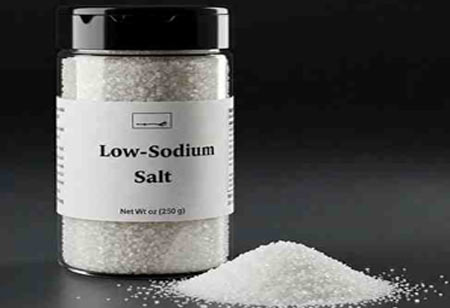Thank you for Subscribing to Food Business Review Weekly Brief
- Home
- Topics
- Alternative Proteins and Plant Based Food
- Beer and Wine
- Canned Beverages
- Coffee And Tea
- Food and Beverage Consulting
- Food and Beverage Financial Service
- Food And Beverages Marketing
- Food Distributors
- Food Ingredients
- Food Sustainability
- Plant Based Food and Beverages
- Seafood Suppliers
- Supplement Manufacturing
- Wine Investment
- News
- Vendor Viewpoint
- CXO Insights
- Conferences
- Newsletter
- CXO Awards
-
Shaping the Future of Health-Conscious Foods with Low-Sodium Salt Technology

By
Food Business Review | Friday, April 18, 2025
Stay ahead of the industry with exclusive feature stories on the top companies, expert insights and the latest news delivered straight to your inbox. Subscribe today.

The global food industry is transforming, driven by increased consumer health and wellness awareness and supported by proactive public health initiatives worldwide. Central to this evolution is the growing emphasis on reducing dietary sodium intake—a factor closely associated with various chronic health conditions. As a result, developing and applying advanced low-sodium salt technologies has evolved from a niche interest to a mainstream priority for food manufacturers across multiple product categories. This trend reflects consumer demand and highlights significant advancements in food science and ingredient innovation, enabling the creation of flavorful, functional foods with markedly lower sodium chloride content.
From Gradual Reduction to Technological Innovation
Conventionally, sodium reduction strategies began with gradually reducing added salt, allowing consumer palates to adjust over time. While this method achieved some success, it presented limitations, particularly in products where salt performs essential functions beyond flavor enhancement. A pivotal technological advancement emerged by identifying direct sodium chloride alternatives, notably potassium chloride (KCl). Owing to its similar ionic properties, KCl delivers a comparable level of saltiness and replicates several functional attributes of sodium chloride. Its use can reduce sodium by 30 percent or more in products such as meat, cheese, and bread, often without a noticeable decline in sensory quality. To further optimize performance and taste, mineral salt blends incorporating calcium chloride, magnesium salts, and other components have been developed, expanding the toolkit for sodium replacement.
Nevertheless, the widespread use of potassium chloride has revealed sensory challenges, particularly a tendency to produce bitter or metallic off-notes at higher concentrations. This challenge has catalyzed innovation in taste masking and flavor modification technologies. Research in flavor science has identified various natural compounds capable of mitigating these off-notes. For instance, parsley extracts rich in apiin and essential oils such as Peru balsam are being explored for their bitterness-masking properties. These are often combined with specific amino acids (e.g., arginine or lysine) or ketone compounds (e.g., acetoin or diacetyl) to enhance their efficacy and improve the overall taste profile of KCl-based formulations.
Enhancing Saltiness Perception with Functional Ingredients
Beyond masking undesirable flavors, significant progress has been made in enhancing the perception of saltiness, enabling further sodium reduction while preserving consumer acceptance. Yeast extracts, rich in nucleotides and peptides, have emerged as valuable tools. These extracts contribute umami and savory background notes that add flavor complexity and amplify the perceived intensity of saltiness. Additionally, amino acids such as L-lysine, L-histidine, and L-arginine serve as effective flavor enhancers, primarily when used synergistically with mineral salt replacers. Traditional enhancers like monosodium glutamate (MSG), which contains less sodium than table salt, and high-nucleotide compounds such as disodium inosinate and guanylate, also play a critical role in building full-bodied flavor profiles in reduced-sodium formulations.
Another promising area of innovation lies in the physical modification of salt crystals. Recognizing that the rate and manner in which salt dissolves in the mouth influences perceived saltiness, researchers have engineered salt particles with novel structures. Techniques such as creating micro-sized crystals, hollow spheres, or non-cubic geometries have increased surface area and accelerated saliva dissolution, enhanced the initial burst of saltiness while required less overall sodium chloride. Encapsulation methods, where salt particles are coated with other substances, offer further control over the release profile, delivering targeted saltiness during chewing and optimizing sensory impact. These structural modifications enable sodium reduction without relying solely on alternative ingredients.
Preserving Functional Roles of Salt in Reformulated Foods
Significantly, the functional roles of sodium chloride extend well beyond flavor. Salt contributes to preservation, texture, fermentation control, and water binding, which are critical for producing bread, processed meats, and dairy products. Therefore, successful sodium reduction strategies must address these functional roles. Potassium chloride-based blends can partially replicate these attributes, while hydrocolloids and cross-linking agents are increasingly used to maintain desired textures and moisture retention. In terms of preservation, reducing salt levels often requires reinforcing other elements within the multi-hurdle preservation framework, including pH adjustment, the incorporation of natural preservatives (e.g., plant extracts, cultured ingredients), and more rigorous temperature management.
This push toward sodium reduction has also encouraged a broader focus on flavor development within foods. Manufacturers are increasingly maximizing the inherent flavors of base ingredients and leveraging culinary techniques to enhance complexity. Using herbs, spices, umami-rich foods (e.g., tomatoes, mushrooms), and other natural flavor contributors allows for a more layered and satisfying taste experience, reducing reliance on salt as the primary flavor driver.
Low-sodium salt technology is rapidly evolving and characterized by multifaceted approaches extending well beyond basic salt substitution. Advances in taste masking, saltiness enhancement through amino acids and yeast extracts, physical salt modification, and the preservation of salt's functional roles collectively support the creation of high-quality, health-conscious food products. This comprehensive innovation ecosystem is fueled by growing health awareness and regulatory pressures, empowering manufacturers to meet consumer expectations without compromising flavor, texture, or safety. Ongoing research and development promise even more sophisticated solutions, paving the way for a healthier global food landscape that balances nutritional responsibility with sensory satisfaction.






